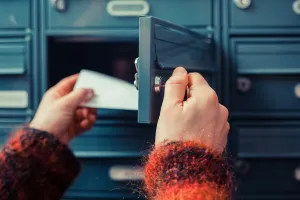
Closeup on a woman’s hand as she is getting her post out of her letterbox
If you feel like the mail seems to be moving slower these days, it’s not just your imagination.
In October 2021, the United States Postal Service (USPS) implemented a 10-year plan designed to tackle its long-standing financial woes with cost-cutting and revenue-increasing measures. One specific change outlined in the plan was longer delivery timeframes, as the USPS increased its service standards—the length of time for a piece of mail to be delivered—to two to five days for first-class mail, up from its previous standard of no more than three days.
And, more changes are on the horizon, as evidenced by a planned rate increase scheduled for July. The USPS has announced its intention to increase the price of forever stamps from $0.58 to $0.60 at that time.
These changes have created more than a few headaches in a time when people are relying on the USPS and other delivery services more and more. Between drastic supply chain increases and USPS operational shifts, there are many logistical challenges for businesses to work through right now.
However, despite the evolving delivery landscape, there is reason for continued faith in traditional mail.
For example, direct mail continues to be a proven way for businesses to reach new customers. According to Jeff Heyman, vice president of product development and e-commerce for FedEx Office, recent data indicates that direct mail convinced 39 percent of customers to try a business for the first time and 60 percent to visit a promoted website.
Traditional mail also remains a mainstay in bill pay options. The most recent USPS Household Diary Study showed that more than 60 percent of households still prefer to receive paper bills. However, USPS delays can mean a bill is late in arriving or in being paid, and the rate increases impact everyone from businesses to consumers. It’s wise for vendors to diversify their bill pay options, a move consumers indicate they are eager to embrace. In 2020, the number of bills being paid online surged, with 90 percent of households reporting electronic bill payments and only 55 percent paying bills through the mail.
Savvy businesses should embrace the opportunities of traditional mail while recognizing the convenience and improved customer satisfaction that comes from hybrid bill pay options. By utilizing both traditional and emerging communication and bill pay channels, businesses can create a win-win scenario that reduces friction and improves customer retention.
At Matrix, our omnichannel platform ensures customer communications are delivered across multiple channels based on customer preference. From high-quality transactional mail to marketing communications solutions to convenient e-Solutions, Matrix is your comprehensive service partner offering industry-leading quality and service in integrated electronic printing and mailing business solutions. We offer a full complement of multi-channel communication programs and services including lead generation, acquisition and retention marketing programs, surveys, email and text messaging solutions. In addition, our compliance and security processes offer you peace of mind and certainty for business continuity.
Contact us today to get started.




